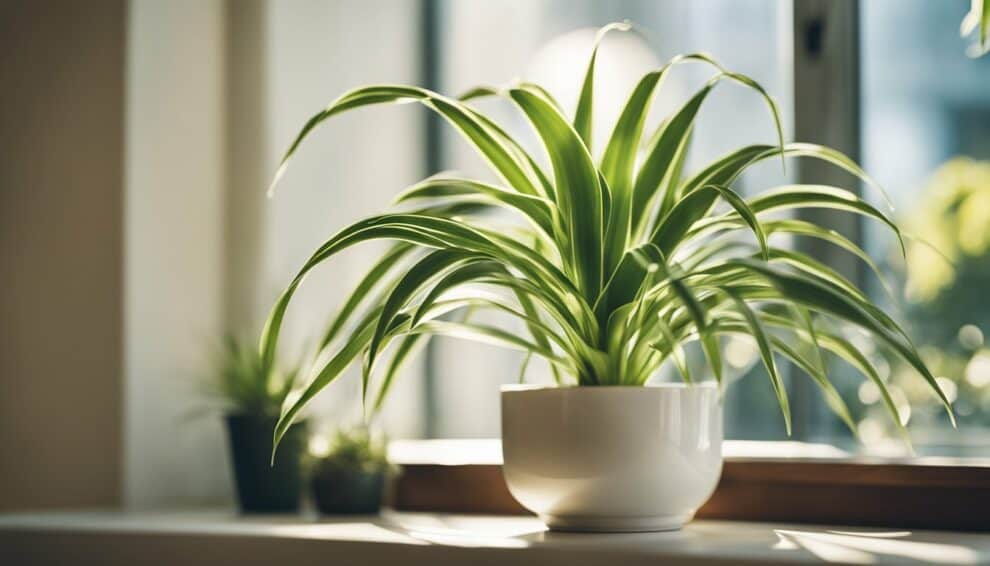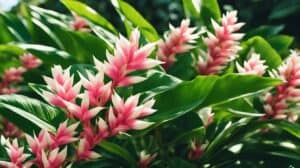Spider plants, also known as Chlorophytum comosum, are a popular choice for indoor houseplants due to their easy care and air-purifying properties.
These plants are native to tropical and southern Africa and have long, slender leaves that grow in a rosette pattern.
Spider plants are also known for their ability to produce babies, or plantlets, which can be propagated to create more plants.

If you’re new to caring for spider plants, it can be overwhelming to know where to start.
That’s why this ultimate guide will provide you with all the information you need to keep your spider plant thriving indoors.
From the ideal growing conditions to common issues and solutions, this guide has got you covered.
Whether you’re a seasoned plant parent or a beginner, this guide will help you take your spider plant care to the next level.
Understanding Spider Plants
Species Overview
Spider plants, scientifically known as Chlorophytum comosum, are a popular houseplant that are easy to care for and can thrive in a variety of environments.
These plants are native to South Africa and are known for their long, narrow leaves that grow in a rosette pattern.
Spider plants are also known for their ability to produce small, white flowers that eventually turn into small plantlets or “spiderettes”.
There are several different varieties of spider plants, including the variegated spider plant, which has green and white striped leaves, and the curly spider plant, which has curly leaves that resemble a spider’s legs.
Growth Habits
Spider plants are known for their ability to grow quickly and easily. They can grow up to 2 feet in length and prefer bright, indirect light.
However, they can also tolerate low light environments, making them a great choice for offices or homes with limited natural light.
Spider plants prefer well-draining soil and should be watered regularly, but not over-watered.
Over-watering can lead to root rot, which can be fatal to the plant.
Spider plants also benefit from occasional fertilization, especially during the growing season.
Spider plants are also known for their air-purifying properties.
They can help remove toxins from the air, making them a great choice for homes or offices with poor indoor air quality.
Overall, spider plants are a great choice for beginner plant enthusiasts or anyone looking for a low-maintenance houseplant that can add a touch of green to their indoor space.
Essentials of Spider Plant Care

Spider plants are easy to care for and make a great addition to any indoor space.
Here are some essential tips to help you keep your Chlorophytum Comosum thriving.
Lighting Requirements
Spider plants prefer bright, indirect light. Direct sunlight can scorch their leaves, so it’s best to keep them in a spot that gets filtered light.
If your spider plant’s leaves start to turn brown, it may be getting too much direct sunlight.
On the other hand, if the leaves are pale and yellow, it may not be getting enough light.
In that case, you can move it to a brighter spot or consider using a grow light.
Watering Techniques
Spider plants like to be kept evenly moist, but not too wet.
Overwatering can lead to root rot, so it’s important to let the soil dry out slightly between waterings.
A good rule of thumb is to water your spider plant when the top inch of soil feels dry to the touch.
When you water, make sure to give it a good soak, allowing the water to drain out the bottom of the pot.
Soil and Potting Mix
Spider plants prefer well-draining soil. You can use a standard potting mix or make your own by mixing equal parts peat moss, perlite, and vermiculite.
It’s also a good idea to repot your spider plant every year or two to give it fresh soil and room to grow.
Temperature and Humidity Needs
Spider plants are adaptable and can tolerate a wide range of temperatures, but they prefer temperatures between 60-75°F (15-24°C).
They also appreciate moderate humidity, so it’s a good idea to mist their leaves occasionally or place a humidifier nearby.
By following these essential tips, you can keep your spider plant healthy and thriving for years to come.
Propagation and Repotting

Propagating Spiderettes
Spider plants are known for their ability to produce spiderettes, which are small plantlets that grow on the parent plant.
These spiderettes can be easily propagated to create new spider plants. To propagate spiderettes, follow these steps:
- Wait until the spiderette has grown to at least 2-3 inches in length and has developed a few roots.
- Carefully cut the spiderette off the parent plant, making sure to include some of the roots.
- Plant the spiderette in a small pot filled with well-draining potting soil.
- Water the spiderette regularly and keep it in a bright, indirect light.
In a few weeks, the spiderette will begin to grow and develop into a full-sized spider plant.
Propagating spiderettes is an easy and fun way to expand your spider plant collection.
When and How to Repot
Spider plants are relatively easy to care for and don’t require frequent repotting.
However, if you notice that your spider plant is becoming root-bound or the soil is starting to dry out quickly, it may be time to repot.
Here are some tips for repotting your spider plant:
- Choose a pot that is slightly larger than the current pot.
- Fill the bottom of the new pot with a layer of well-draining potting soil.
- Carefully remove the spider plant from its current pot, being careful not to damage the roots.
- Place the spider plant in the new pot and fill in the gaps with potting soil.
- Water the spider plant thoroughly and place it in a bright, indirect light.
Repotting your spider plant can help it thrive and grow to its full potential.
Just be sure not to overwater it, as spider plants prefer to be slightly dry between waterings.
Troubleshooting Common Issues

Pest Prevention
Spider plants are generally resistant to pests, but they can still fall victim to spider mites, mealybugs, and scale insects.
To prevent infestations, it’s important to keep your plant healthy and well-maintained.
Regularly check for signs of pests, such as webbing, sticky residue, or tiny insects on the leaves.
If you do notice pests, isolate the affected plant and treat it immediately with insecticidal soap or neem oil.
Addressing Brown Leaf Tips
Brown leaf tips are a common issue with spider plants and can be caused by a variety of factors, including overwatering, underwatering, low humidity, or exposure to cold drafts.
To address this issue, start by trimming off the brown tips with sharp scissors. Then, adjust your watering and humidity levels accordingly.
Spider plants prefer to dry out slightly between waterings, so make sure the soil is not constantly damp.
To increase humidity, you can place a tray of water near the plant or use a humidifier.
Reviving a Neglected Spider Plant
If your spider plant has been neglected and is looking sad and droopy, don’t worry – it’s not too late to revive it.
Start by giving it a good watering and placing it in a bright, indirect light.
If the soil is very dry, you may need to water it a few times over the course of a few hours to ensure it is fully hydrated.
You can also give your plant a boost by fertilizing it with a balanced fertilizer every few weeks.
With a little TLC, your spider plant should start to perk up in no time.
Frequently Asked Questions

How can I ensure my spider plant stays healthy during winter?
During winter, spider plants may require some extra care to thrive.
One way to ensure your spider plant stays healthy during winter is to keep it away from cold drafts and maintain a consistent temperature.
You can also water your spider plant less frequently during winter, as it may not require as much water as it does during warmer months.
Additionally, you can mist your spider plant to increase humidity levels around it.
What steps can I take to encourage a bushier growth in my spider plant?
If you want to encourage bushier growth in your spider plant, you can prune it regularly.
Pruning involves removing the spider plant’s offshoots or baby spider plants, which redirects the plant’s energy towards the main plant, resulting in a bushier growth.
You can also fertilize your spider plant with a balanced fertilizer during the growing season to encourage healthy growth.
What are the benefits of having a spider plant indoors?
Spider plants are great indoor plants that offer several benefits.
They are known for their air-purifying properties, as they can remove harmful toxins from the air.
Additionally, spider plants are easy to care for and can thrive in a wide range of lighting conditions, making them a great choice for beginners.
What is the ideal watering schedule for a spider plant during colder months?
During colder months, spider plants require less water than they do during warmer months.
The ideal watering schedule for a spider plant during colder months is to water it once every two to three weeks.
However, it’s important to check the soil moisture level before watering to ensure that the plant is not overwatered.
How should I care for and propagate spider plant offshoots?
To care for spider plant offshoots, you can plant them in a separate pot with fresh soil, water them regularly, and provide them with adequate lighting.
Propagating spider plant offshoots is easy, as they can be simply removed from the main plant and planted in a separate pot.
You can also propagate spider plant offshoots by placing them in water until they develop roots and then planting them in soil.
Is it necessary to trim brown tips on spider plant leaves, and how should I do it?
Trimming brown tips on spider plant leaves is not necessary, but it can improve the plant’s appearance.
To trim brown tips, you can use a pair of clean, sharp scissors to cut the affected leaves at an angle.
It’s important to avoid cutting too much of the leaf, as this can damage the plant.














